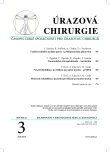NEUROREHABILITATION AFTER SEVERE TRAUMATIC INJURY – REVIEW
Authors:
Tomáš Brož 1; Albert Kharisov 1; Martin Carda 2
Authors place of work:
Department of Neurosurgery, Regional Hospital Pardubice, a. s.
1; Neurochirurgické oddělení, Pardubická Krajská Nemocnice, a. s.
1; Department of Trauma Surgery, Department of Surgery, Regional Hospital Pardubice, a. s.
2; Oddělení Úrazové chirurgie, Chirurgická klinika, Pardubická krajská nemocnice, a. s.
2
Published in the journal:
Úraz chir. 22., 2014, č.3
Summary
INTRODUCTION:
Craniocerebral injuries belong among the most frequent serious and often debilitating injuries. Patients after completion of acute health care should achieve optimal quality of life. An early rehabilitation also has great influence in achieving this goal. Its role is mainly to support spontaneous regeneration and to use brain plasticity. We assume that the progression of neuronal plasticity can be influenced by stimuli from the environment, such as acoustic, visual, tactile, and thus restores or reorganizes function of damaged brain areas. Optimal use of spontaneous regeneration and neuronal plasticity is one of the most important goals of modern neurorehabilitation.
DISCUSSION:
The key Factors in neurorehabilitation are the demands of exercise, nonspecific activation and stimulations, colorful environments and specific exercises for impaired function. For the future, it is necessary to carry out more studies that would reveal the mechanisms of stimulation of behavior at different time intervals, and which would determine a link between treatment, intensity and its duration and functional recovery. It is also necessary to put in place a program of treatment that would include all stages of recovery - from the acute phase to the long-term chronic one.
CONCLUSION:
Despite the positive results when using early rehabilitation we are still confronted with a certain number of patients with a variety of persisting deficits, not only of sensorimotor functions, but also behavior and communication disorders their further improvement is extremely important for achieving higher level of professional and social reintegration. Not only the quality of health care provided to the patients after brain injury and also continuity and regional accessibility of the services belongs among the main determinants of their successful return to occupational and social life.
Key words:
Glasgow coma scale, severe brain injury, neurorehabilitation.
Zdroje
1. ANGEROVÁ, P., ŠVESTKOVÁ, O., SÜSSOVÁ, J. et al. Neurorehabilitace. Česká a slovenská neurologie a neurochirurgie. 2010, 2, 131–135.
2. FROWEIN, RA., TERHAAG, D., AUF DER HAAR, K. et al. Rehabilitation after severe head injury. Acta Neurochir. 1992, 55, 72–74.
3. GAZZELLINI, S., STRAZZER, S., STORTINI, M. et al. Pediatric rehabilitation of severe acquired brain injury: multicentric survey. Eur J Phys Rehabil Med. 2012, 48, 423–431.
4. HELMY, A., VIZCAYCHIPI, M., GUPTA, AK. Traumatic brain injury: intensive care management. Br J Anaesth. 2007, 99, 32–42.
5. International Classification of Functioning, Disability and Health (ICF). Ženeva: WHO, 2001.
6. LIPPERTOVÁ-GRÜNEROVÁ, M. Fázový model neurorehabilitace pacientů s těžkým poškozením mozku. Česká a slovenská neurologie a neurochirurgie. 2011, 1, 11.
7. LIPPERTOVÁ-GRÜNEROVÁ, M. Fázový model neurorehabilitace. Česká a slovenská neurologie a neurochirurgie. 2012, 6, 689–693.
8. LIPPERTOVÁ-GRÜNEROVÁ, M. Neurorehabilitace. Praha: Galén, 2005. 350 s. ISBN 80-7262-317-6
9. NUDO, R., PLAUTZ, EJ., FROST, SB. Role of adaptive plasticity in recovery of function after damage to motor cortex. Muscle Nerve. 2001, 24, 644-649.
10. POWELL, LE., GLANG, A., ETTEL, D. et al. Systematic instruction for individuals with acquired brain injury: results of a randomised controlled trial. Neuropsychol Rehabil. 2012, 22, 85–112.
11. RASQUIN, SMC., BOUWENS, SFM., DIJCKS, B. et al. Effectiveness of a low intensity outpatient cogntive rehabilitation programme for patients in the chronic phase after acquired brain injury. Neuropsychological Rehabilitation. 2010, 20, 760–777.
12. SMRČKA, M., FADRUS, P., NEUMAN, E., GÁL, R. Použití mírné hypotermie v neurochirurgii. Časopis lékařů českých. 2005, 144, 26–30.
13. SMRČKA, M., ŠVESTKOVÁ, O., NAVRÁTIL, O. Kraniocerebrální poranění a možnosti následné neurorehabilitace - popis problematiky a přehled literatury. Neurologie pro praxi. 2013, 2, 80 –83.
14. SUNDBERG, J., ESTRADA, C., JENKINS, C. et al. Hypothermia is associated with poor outcome in pediatric truama patients. Am J Emerg Med. 2011, 29, 1019–1022.
15. ŠVESTKOVÁ, O. Základní principy současné neurorehabilitace. Neurologie pro praxi. 2013, 3, 136–139.
16. ŠVESTKOVÁ, O., PFEIFFER, J. Funkční hodnocení (diagnostika) v rehabilitaci. Praktický lékař. 2009, 5, 268–271.
17. VAŇÁSKOVÁ, E. Testování v neurorehabilitaci. Neurologie pro praxi. 2005, 6, 311–314.
18. VOS, PE., VAN VOKUILEN, AC., BEEMS, T. et al. Evaluation of the traumatic coma data bank computed tomography classification for severe head injury. J Neurotrauma. 2001, 18, 649–655.
19. WERNER, C., ENGELHARD, K. Pathophysiology of traumatic brain injury. Br J Anaesth. 2007, 99, 4–9.
Štítky
Chirurgia všeobecná Traumatológia Urgentná medicínaČlánok vyšiel v časopise
Úrazová chirurgie

2014 Číslo 3
- Metamizol jako analgetikum první volby: kdy, pro koho, jak a proč?
- Fixní kombinace paracetamol/kodein nabízí synergické analgetické účinky
- Antidepresivní efekt kombinovaného analgetika tramadolu s paracetamolem
- Geriatrická křehkost a léčba bolesti
- Kombinace metamizol/paracetamol v léčbě pooperační bolesti u zákroků v rámci jednodenní chirurgie
Najčítanejšie v tomto čísle
- NEUROREHABILITACE PO TĚŽKÉM PORANĚNÍ MOZKU – PŘEHLED
- MOŽNOSTI REHABILITACE PACIENTŮ PO TĚŽKÉM PORANĚNÍ MOZKU
- TRAUMATICKÁ ASTRAGALEKTÓMIA – kazuistika
- Přečetli jsme za vás
